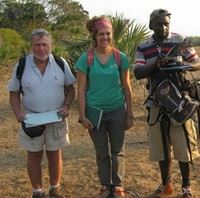Research Projects Take Undergraduate Students to New Global Vistas
Rutgers undergraduate participants with the Aresty Research Center have the opportunity to do research abroad under university faculty
Andrea Kennedy leafed through rare 18th-century texts in a London library, while Syed Abbas and Nicholas Greene visited Nigerian farmland to study crops that might grow in New Jersey. Anna Sherman witnessed the challenges facing a bilingual Arab-Israeli elementary school in Israel, and Martin Mosteiro Romero compared green building practices in Switzerland to those in New Jersey.
The students’ projects will be among 340 on display this week at the sixth annual Aresty Undergraduate Research Symposium. More than 425 students will present their research April 23 in panel discussions and a poster session at the Rutgers Student Center from 10 a.m. to 4 p.m.
As in past years, student presentations are representative of the diverse disciplines found at Rutgers, including the life, social, and physical sciences; mathematics; engineering; and the arts and humanities. The symposium is just one of the many programs that thrive in the center, thanks to the generosity of the late Jerome Aresty and his wife Lorraine, who provided the funding to start the center in 2004.
Each student researcher works with a Rutgers faculty advisor whose scholarly research and interests are relevant to the student’s project. Advisors mentor and guide students through the process of designing their research projects and carrying them out, often earning their mentees’ praise for “keeping me on track.”
Overseas, they might find mentors to help guide their Rutgers projects. Sherman was drawn to her project by a professor at

In some cases, faculty advisors are by their sides on their journeys. Jack Harris, professor of anthropology and director of the Koobi Fora Field School in northern Kenya, advised Kate Barbour, whose vegetation study during the 2009 field school was intended to shed light on the plant life that nurtured humans and non-human primates in prehistoric times.
“Going to Africa gave Kate an extraordinary opportunity to develop her skills and to conduct innovative research,” Harris said. “By attracting bright, young undergraduate students like Kate, I can expand aspects of my research that would not possible in smaller groups.”
Whether doing their projects close to home or traveling abroad, undergraduates come away with confidence in their research abilities, and valuable skills and experience for the next stage of their academic or professional lives, according to Justine Hernandez Levine, director of the Aresty Research Center.
“Rutgers prepares students to take on the challenges of the world,” Hernandez Levine said. “It makes sense for us to give our undergraduates the opportunity to try real problem solving in the world and to give them the support they need to make a genuine contribution. Our students do this in our New Jersey back yards, but it is important to us that they are also able to do so globally.”
Read more about the students' projects by clicking on their names:






Media Contact: Sandra Lanman
732-932-7084, ext. 621
E-mail: slanman@ur.rutgers.edu